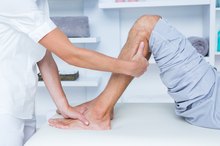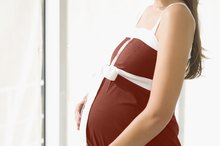Causes of Pain in the Leg After a C-Section
For the safety and well-being of both the mother and the baby, the American College of Obstetricians and Gynecologists recommends vaginal delivery unless there is medical reason for a cesarean section. Nonetheless, C-sections account 32 percent percent of all deliveries in the United States, according to 2014 data from the Centers for Disease Control and Prevention 2. Although relatively common, a C-section is major surgery and is associated with certain side effects and risks for both the baby and the mother. Some of these effects can manifest as leg pain in the mother, which can occur for different reasons.
If you are experiencing serious medical symptoms, seek emergency treatment immediately.
Deep Vein Thrombosis
Deep vein thrombosis, or DVT, refers to the development of a blood clot in a deep vein of the body. These clots most commonly form in the legs. DVT risk is increased during pregnancy and for approximately 6 to 8 weeks after delivery, the postpartum period. DVT risk during the postpartum period is significantly higher for women undergoing a C-section than for those who deliver vaginally. Symptoms of a DVT in the leg include warmth, redness, pain and swelling in one of the legs. Symptoms may involve the calf, back of the knee, thigh or the entire leg, depending on the location of the clot. A low fever can also occur.
Although fewer than 1 out of every 100 women develop a postpartum DVT, this condition is potentially life-threatening. The most significant danger of a DVT involves part of the clot breaking loose and traveling to the lungs. This condition, known as a pulmonary embolism, can cause a critical and possibly life-threatening blockage of blood flow through the lungs.
- Deep vein thrombosis, or DVT, refers to the development of a blood clot in a deep vein of the body.
- This condition, known as a pulmonary embolism, can cause a critical and possibly life-threatening blockage of blood flow through the lungs.
Muscle Fatigue and Fluids
A Blood Clot in a Leg or a Calf Muscle Cramp?
Learn More
If your C-section wasn't planned but rather decided on after a trial of labor, you might experience some muscle soreness in your legs after delivery related to labor positions. For example, squatting, kneeling, crouching or holding your knees to your chest for extended periods of time can make your legs sore.
Another possibility is an accumulation of fluid in your legs due to intravenous fluids given before and during your C-section. This can make your legs feel heavy and uncomfortable, but typically goes away within a few days.
- If your C-section wasn't planned but rather decided on after a trial of labor, you might experience some muscle soreness in your legs after delivery related to labor positions.
Nerve Injury
Women undergoing a C-section are positioned lying flat on an operating table but the lower body is often tilted to reduce pressure on the blood vessels that supply the placenta to ensure adequate oxygen delivery to the fetus. Prolonged positioning for a C-section sometimes compresses nerves that can result in leg pain, numbness or tingling after the procedure. This type of nerve injury is rare and generally resolves over several days to weeks.
Regional anesthesia, which is used for the majority of C-sections in the U.S., allows mothers to remain awake and alert during the procedure. Rarely, temporary nerve irritation or injury can occur with this type of anesthesia, which might cause leg pain after a C-section. In most cases, the pain resolves within a few days.
- Women undergoing a C-section are positioned lying flat on an operating table but the lower body is often tilted to reduce pressure on the blood vessels that supply the placenta to ensure adequate oxygen delivery to the fetus.
- Prolonged positioning for a C-section sometimes compresses nerves that can result in leg pain, numbness or tingling after the procedure.
Compartment Syndrome
Breastfeeding & Leg Pains
Learn More
Compartment syndrome is another rare complication that can occur after a C-section 7. With this condition, swelling in the leg after the procedure reduces blood supply to the muscles. This leads to pain, weakness and eventually numbness. Extensive blood loss during labor and delivery, low blood pressure, and use of medication to induce or speed the progression of labor increase the risk for compartment syndrome. Emergency surgery may be needed to relieve the pressure and reestablish adequate blood flow to the affected leg.
- Compartment syndrome is another rare complication that can occur after a C-section 7.
- With this condition, swelling in the leg after the procedure reduces blood supply to the muscles.
Warnings and Precautions
Contact your pregnancy healthcare provider right away if you experience new or worsening leg pain once you've returned home after a C-section, especially if your symptoms suggest the possibility of a DVT. Seek emergency medical care if you experience signs or symptoms of a pulmonary embolism, including: -- shortness of breath or rapid breathing -- chest pain -- cough -- dizziness, lightheadedness or fainting -- a rapid or pounding heartbeat
Reviewed and revised by: Tina M. St. John, M.D.
Related Articles
References
- Merck Manual Professional Version: Deep Venous Thrombosis (DVT)
- Centers for Disease Control and Prevention: Births -- Method of Delivery
- Neurology and Pregnancy: Clinical Management; Michael S. Marsh, et al.
- Deep Vein Thrombosis: A Multidisciplinary Approach: O. P. Yadava
- Merck Manual Professional Version: Pulmonary Embolism (PE)
- Labor and Delivery Nursing: Guide to Evidence-Based Practice; Michelle Murray and Gayle Huelsmann
- Journal of Medical Case Reports: Acute Lower Limb Compartment Syndrome After Cesarean Cection: A Case Report
- International Journal of Obstetric Anesthesia: A Case of Sciatic Neuropathy After Caesarean Section Under Spinal Anaesthesia
- Anaesthesia: Peripheral Nerve Injuries Associated With Anaesthesia
- Evidence-Based Practice of Anesthesiology, 3rd Edition; Lee A. Fleisher
Writer Bio
A registered nurse with more than 25 years of experience in oncology, labor/delivery, neonatal intensive care, infertility and ophthalmology, Sharon Perkins has also coauthored and edited numerous health books for the Wiley "Dummies" series. Perkins also has extensive experience working in home health with medically fragile pediatric patients.









